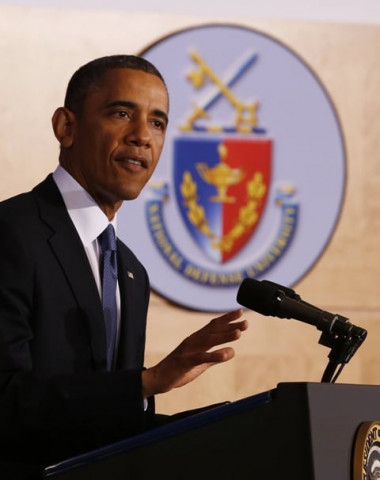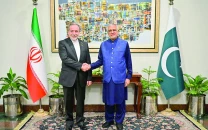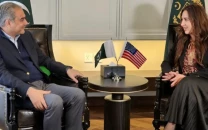Obama tackles drones, Guantanamo in reset of war on terror
President Barack Obama addresses the United States in a major policy speech from National Defense University.

US President Barack Obama speaks about his administration's counterterrorism policy at the National Defense University at Ft McNair in Washington, May 23, 2013. PHOTO: AFP
In a major policy speech, Obama said the United States faced a new threat from "diverse" terror franchises and the growing threat of homegrown radicals, after putting al Qaeda in Pakistan and Afghanistan on the path to defeat.
"We must define the nature and scope of this struggle, or else it will define us," Obama warned at the National Defense University, seeking to reframe US counter-terrorism posture more than a decade after the September 11 attacks.
"Neither I, nor any President can promise the total defeat of terror ... what we must do -- is dismantle networks that pose a direct danger," Obama said.
Specifically, Obama said he would lift a personal moratorium on transferring Guantanamo Bay inmates to unstable Yemen, and said he would appoint a new senior envoy to oversee transfers.
He also called on the Pentagon to designate a site on US soil to hold military tribunals for terror suspects now at Guantanamo Bay, and said Congress must work with him to close a facility that has stained the US image abroad.
"I know the politics are hard. But history will cast a harsh judgment on this aspect of our fight against terrorism, and those of us who fail to end it," Obama said.
"Imagine a future -- ten years from now, or twenty years from now -- when the United States of America is still holding people who have been charged with no crime on a piece of land that is not a part of our country."
The new effort to close Guantanamo, to try to honor a promise that Obama broke in his first White House term, comes with 103 of the remaining 166 inmates on a hunger strike.
In a rare public discussion of the US covert drone program, Obama said that targeting terrorists with unmanned aerial vehicles was a legal, effective and just military tactic.
But he revealed he had signed a new presidential policy directive "insisting on upon clear guidelines, oversight and accountability."
The guidance includes requirements that a target must pose a continuing "imminent" threat to Americans, and says lethal action can be used only if a suspect cannot feasibly be captured, and there is a legal basis for acting.
It also requires the "near certainty that non-combatants will not be injured or killed," according to a White House fact sheet.
The rules for targeting suspects in places like Somalia, Yemen and Pakistan would follow the same criteria as those used for attacks on US citizens who have aligned themselves with foreign terror groups.
Such criteria however would still give the administration the power to launch strikes against targets seen as plotting "imminent" terror attacks against the United States -- a definition leaving wide latitude for action.
On Wednesday, the administration admitted for the first time that it had killed Yemeni-American cleric Anwar al Awlaki in a drone strike in Yemen in 2011 -- and three other US citizens also died in anti-terror strikes abroad.
Awlaki's killing prompted a fierce constitutional debate over whether the president has the right to order the death of a US terror suspect without offering due process.
He may also name a new high-level official to manage the closure of the camp and could transfer CIA drone war functions to the Pentagon.
Obama has blamed fierce opposition in Congress for the halting of transfers -- though he imposed his own moratorium on sending inmates home to unstable Yemen.



















COMMENTS
Comments are moderated and generally will be posted if they are on-topic and not abusive.
For more information, please see our Comments FAQ